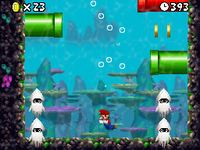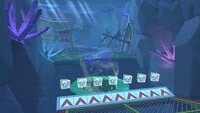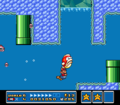Jet Pipe
| Jet Pipe | |
|---|---|
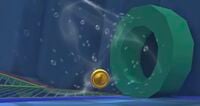 Screenshot from Mario Kart Tour | |
| First appearance | Super Mario Bros. 3 (1988) |
| Latest appearance | Super Mario Bros. Wonder (2023) |
| Effect | Expels water that pushes the player character |
| Variant of | Warp Pipe |
Jet Pipes,[1] originally referred to as bubble-jet pipes,[2] are underwater objects in the Super Mario franchise. They are pipes that release strong currents of water. In the Super Mario series, the water pushes the player character. In some contexts, Jet Pipes can be used to avoid oncoming enemies, such as Cheep Chomps and Mega Maw-Rays. In the Mario Kart series, the pipes appear in the underwater portions of certain courses. Driving into their streams brings the player character to higher routes, and they can be used to avoid sinking down into pits.
Currents have appeared independently from Jet Pipes. In games where they cooccur, the natural currents are usually hazards that pull the player character into the level's abyss, costing them a life. In games where there are only natural currents, they typical function like Jet Pipes.
History[edit]
Super Mario series[edit]
Super Mario Bros. 3 / Super Mario Advance 4: Super Mario Bros. 3[edit]
Bubble-jet pipes first appear in the underwater levels of Super Mario Bros. 3, in which they expel jets of water that push Mario or Luigi as he swims. Bubble-jet pipes can be green or blue. The first one is introduced in Water Land's World 3-1. Mario or Luigi can overcome the currents if he is in his Frog form when the player presses . In World 4-4 and World 6-9, some of them can be entered like normal Warp Pipes to reach hidden sub-areas.
In Super Mario All-Stars and Super Mario Advance 4: Super Mario Bros. 3, the bubble-jet pipes are green, like the normal pipes found on land. In addition to the original levels, two bubble-jet pipes appear in An Aqueous Adventure in World-e.
New Super Mario Bros.[edit]
Bubble-jet pipes appear in underwater courses in New Super Mario Bros., first appearing in World 3-1. In this game, the pipes appear in a variety of colors and are visually indistinguishable from the Warp Pipes found on land. In several courses, the currents from the bubble-jet pipes must be carefully navigated in order to collect a Star Coin. In World 3-3 and 4-3, pressing a ? Switch located near the pipes turns the currents off for a temporary period of time. In World 8-3, bubble-jet pipes can be used to outpace an oncoming Mega Unagi.
New Super Mario Bros. Wii[edit]
Bubble-jet pipes appear in underwater and beach courses in New Super Mario Bros. Wii and function as they did in prior games. Though largely restricted to World 4, a tropical archipelago, bubble-jet pipes first appear in World 1-4. Some of them are positioned in ways that make collecting all of a course's Star Coins more difficult. Like the pipes above ground, the bubble-jet pipes occur in a variety of colors.
In World 4, bubble-jet pipes occur in World 4-1 and World 4-4. They subsequently occur in World 8-4. In World 4-4, the currents coming out of the bubble-jet pipes stop when a nearby P Switch is struck.
New Super Mario Bros. 2[edit]
In New Super Mario Bros. 2, like with their appearance in New Super Mario Bros. Wii, bubble-jet pipes primarily appear in the tropical World 3, but they first appear in World 1-5. In World 3, they appear in World 3-2 and World 3-A. They subsequently appear in World 4-5. Yellow bubble-jet pipes line the leftmost wall of the corridor that makes up World 3-A, generating a continuous stream of water throughout the course.
New Super Mario Bros. U / New Super Luigi U / New Super Mario Bros. Deluxe[edit]
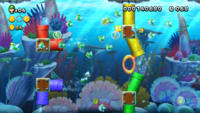
As in previous games, Jet Pipes generate currents of water in New Super Mario Bros. U. Some of them are fastened to giant Empty Blocks and pivot back and forth. They first occur in the hidden course of Acorn Plains, Blooper's Secret Lair, before subsequently appearing in Dragoneel's Undersea Grotto, Porcupuffer Falls, and Swim for Your Life! In the latter three, the player character can take advantage of the Jet Pipes to outpace Dragoneels, Porcupuffers, and Cheep Chomps, respectively. New Super Mario Bros. U is the first use of the English name "Jet Pipe" for this object.
In New Super Luigi U, Jet Pipes first appear in Cheep Chomp Chase. They can be used to evade an oncoming Cheep Chomp, reach a Star Coin, or advance in the course. They finally appear in Star Coin Deep Dive, another course that includes Cheep Chomps. Jet Pipes appear unaltered in the Nintendo Switch release New Super Mario Bros. U Deluxe.
Super Mario Bros. Wonder[edit]
Jet Pipes occur only in the underwater course Robbird Cove in Super Mario Bros. Wonder. The water expelled from the Jet Pipes can direct the player character into nearby enemies or towards safety, but the player character can move against the currents if they have the Dolphin Kick badge equipped. This badge also makes certain Jet Pipes accessible for entry like Warp Pipes. They push coins, Snortoise shells, and Urchins that enter their currents. The first one of the Robbird Cove leads to a hidden 10-flower coin. In other courses, currents are instead generated by sponge-like creatures.
Mario Kart series[edit]
Mario Kart 7[edit]
Mario Kart 7 is the first Mario Kart title to include drivable underwater portions of the courses, and the first one to include bubble-jet pipes. They appear in Wario Shipyard and Piranha Plant Slide. The ones that come out of the sides of the course push the player character similarly to wind. There is one Jet Pipe in Piranha Plant Slide that allows the character to reach the Dash Panel over the last Piranha Plant before the Glide Ramp.
Mario Kart 8 / Mario Kart 8 Deluxe[edit]
In Mario Kart 8 and Mario Kart 8 Deluxe, Jet Pipes appear in Dolphin Shoals and 3DS Piranha Plant Slide. Unlike in Mario Kart 7, the player character can perform a Jump Boost at the arc of the stream. In Dolphin Shoals, Jet Pipes are necessary to reach the back of the Unagi on the course and also provide the player character access to a shortcut.
In the Booster Course Pass DLC for Mario Kart 8 Deluxe, Tour Amsterdam Drift is the first course of the Fruit Cup that was made available in most regions on March 9, 2023 and April 12, 2023 in China. The course combines elements of the different Amsterdam Drift courses from Mario Kart Tour, including the Jet Pipes in Amsterdam Drift 2.
Mario Kart Tour[edit]
Jet Pipes initially appear in the classic courses 3DS Wario Shipyard and 3DS Piranha Plant Slide in Mario Kart Tour. They function as they did in Mario Kart 8, with the giant Jet Pipe in Wario Shipyard allowing the player character to perform a Jump Boost, something they could not do in Mario Kart 7. Jet Pipes also appear in GCN Daisy Cruiser R/T and Amsterdam Drift 2, a course integrated into Mario Kart Tour after it had launched. In addition to those described, there are courses in Mario Kart Tour where the currents do not come out of Jet Pipes.
Mario Party 10[edit]
Currents in Mario Party 10 are interactive objects in Blooper Blastoff that can push away the player's Blooper submarine.
Gallery[edit]
Names in other languages[edit]
| Language | Name | Meaning | Notes |
|---|---|---|---|
| Japanese | 土管水流[3] Dokan Suiryū |
Pipe Current | |
| 水流土管[4] Suiryū Dokan |
Current Pipe | Super Mario Bros. 3, New Super Mario Bros. 2 |
References[edit]
- ^ Stratton, Steve (2012). New Super Mario Bros. U: PRIMA Official Game Guide. Roseville: Prima Games. ISBN 978-0-307-89690-2. Page 54, 55, 90, 120.
- ^ Bueno, Fernando (2009). New Super Mario Bros. Wii: PRIMA Official Game Guide. Roseville: Prima Games. ISBN 978-0-3074-6767-6. Page 28, 29, 75.
- ^ Sakai, Kazuya (Ambit), kikai, Akinori Sao, Junko Fukuda, Kunio Takayama, and Ko Nakahara (Shogakukan), editors (2015). 『スーパーマリオブラザーズ百科: 任天堂公式ガイドブック』. Tokyo: Shogakukan (Japanese). ISBN 978-4-09-106569-8. Page 119, 150, 216.
- ^ ---- (2015). 『スーパーマリオブラザーズ百科: 任天堂公式ガイドブック』. Tokyo: Shogakukan (Japanese). ISBN 978-4-09-106569-8. Page 41, 200.
